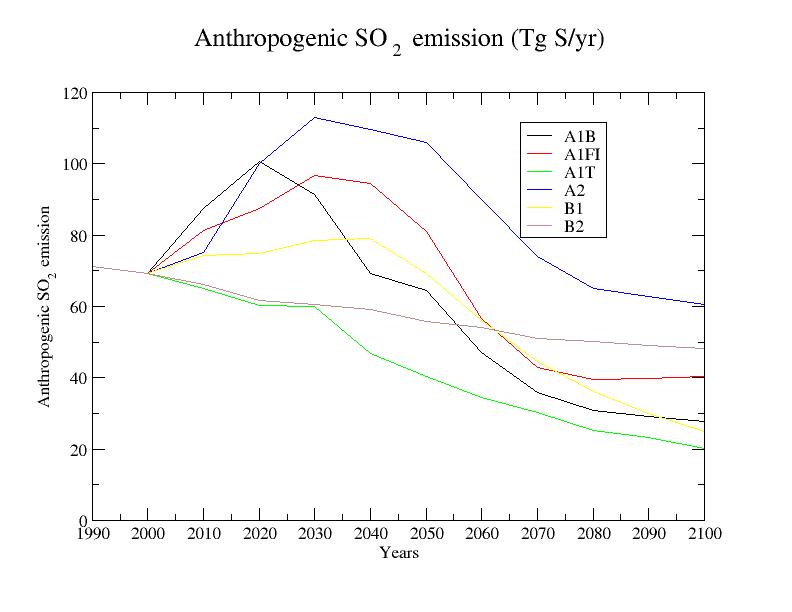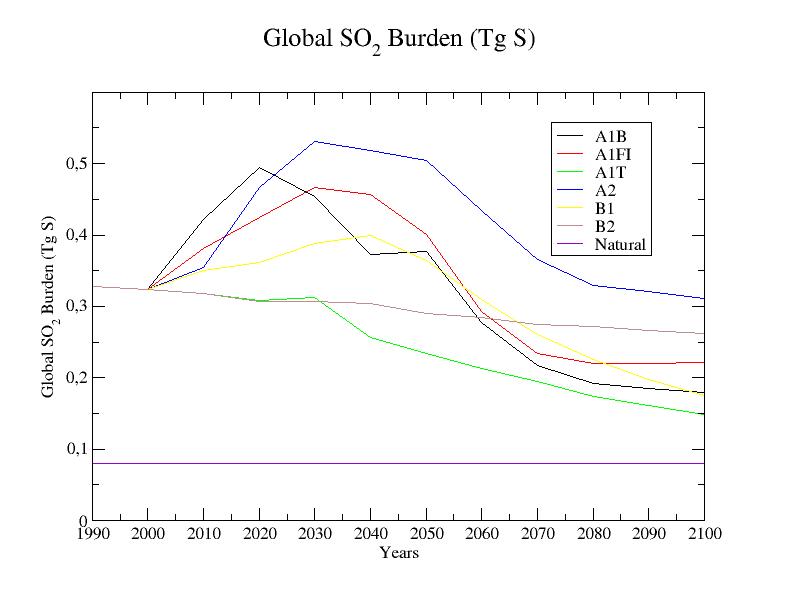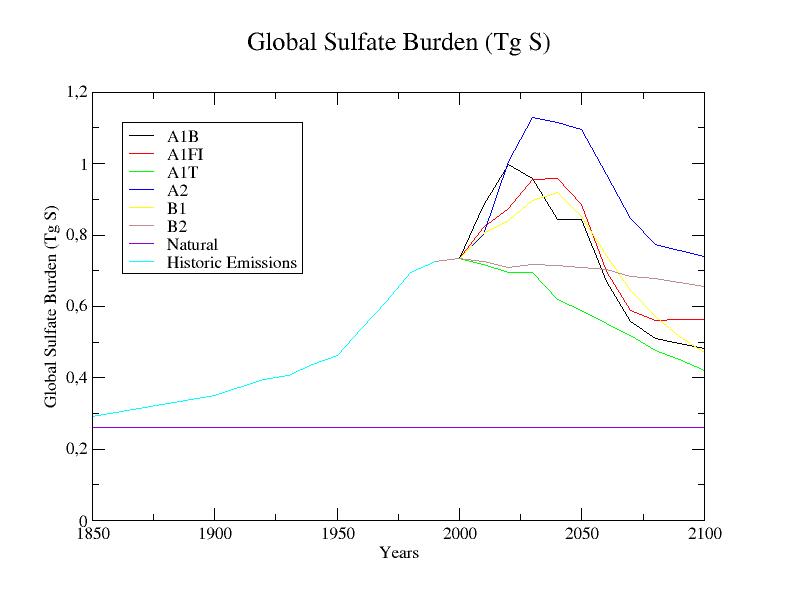Simulation of the sulfur cycle
under SRES scenarios in preparation for IPCC fourth assessement report
Sulfate dry mass are provided for the A1B, A1FI, A1T, A2, B1, and B2 scenarios (Nakicenovic et al., 2000) based on simulations using the LMD GCM (Boucher et al., 2002; Boucher and Pham, 2002). The sulfate fields are in Netcdf format on a regular lat-lon grid of 3.75° by 2.5° and 19 vertical layers and are provided as monthly means in µg SO4 m-3, every 10 years from 1990 to 2100. The natural (ie, preindustrial ~1750), 1850, 1900, and 1920 to 1980 - with a time step of 10 years - sulfate fields are also provided for the groups who want to simulate the XXth century climate or compute aerosol RF relative to the pre-industrial period. The 1850 to 1980 sulfate fields used the historical reconstruction of sulfur emissions by Lefohn et al. (1999) (see Boucher and Pham, 2002) but have been rescaled to the 1990 SRES simulation in order to avoid any discontinuity with SRES scenario in 1990. The corresponding burdens are also provided in the same format and same grid but in unit of mg S m-2.
[Remark 1: mass unit is different for burdens and concentrations, mg S and µg SO4, respectively. The grid is somewhat tricky (but correctly defined in the Netcdf files) so be careful.]
[Remark 2: 1990 and 2000 are same for all IPCC SRES scenarios and are therefore not repeated for the A1B and A2 scenarios.]
[Remark 3: the sulfate burden and concentration files are given for natural conditions as well; natural sulfate can be substracted to the historical and scneario files if needed. ]
[Remark 4: the vertical grid is reversed in the so4.year.rescaled.nc files as compared to the other SRES files. The vertical layers are from top to bottom of the atmosphere in the (historical) rescaled files but from bottom to top in the natural and future SRES files. ]
A series of plots and movies (see below) show the time evolution of the SO2 emission rate and SO2 and sulfate burdens in the three SRES scenarios and the historical reconstruction.
A routine (mie_sul_l.f) is provided to estimate specific extinction coefficient (k, m2/g dry sulfate), asymmetry parameter, g, single scattering albedo, w, as a function of relative humidity (every 10% from 0 to 80%, 85%, 90%, 95%) and wavelength (0.3 µm to 4 µm). We follow here Tang and Munkelwitz (1994) and assume sulfate is in the form of ammonium sulfate with a log-normal size distibution with a dry geometric volume diameter of 0.3 µm and a geometric standard deviation of 2.0 (Boucher and Anderson, 1995).
It is assumed here that all GCMs can incorporate the direct effect of aerosols in a direct manner (ie not by changing the surface albedo for instance). The aerosol optical properties in each waveband of a GCM radiative transfer code can then be estimated by each group using proper spectral averaging over the waveband:
The direct (and if appropriate indirect) RF by sulfate aerosols should be reported using present-day climatological conditions at the top-of-atmosphere. (Those groups who incorporate the effects of BC should additionnally report the direct RF at the surface).
References
O. Boucher, M. Pham, C. Venkataraman, Simulation of the atmospheric sulfur cycle in the Laboratoire de Meteorologie Dynamique General Circulation Model. Model description, model evaluation, and global and European budgets, Note scientifique de l'IPSL n. 23, juillet 2002.
O. Boucher and M. Pham, History of sulfate aerosol radiative forcings, Geophysical Research Letters, 29(9), 1308, 10.1029/2001GL014048, 2002. [file attached 2001GL014048.pdf]
O. Boucher and T. L. Anderson, GCM assessment of the sensitivity of direct climate forcing by anthropogenic sulfate aerosols to aerosol size and chemistry, Journal of Geophysical Research, 100, 26117-26134, 1995.
A. S. Lefohn, J. D. Husar, and R. B. Husar, Estimating historical anthropogenic global sulfur emission patterns for the period 1850-1990, Atmos. Env., 33, 3435-3444, 1999.
N. Nakicenovic, J. Alcamo, G. Davis, B. de Vries, J. Fenhann, S. Gaffin, K. Gregory, A. Grubler, T.Y. Jung, T. Kram, E.L. La Rovere, L. Michaelis, S. Mori, T. Morita, W. Pepper, H. Pitcher, L. Price, K. Raihi, A. Roehrl, H.-H. Rogner, A. Sankovski, M. Schlesinger, P. Shukla, S. Smith, R. Swart, S. van Rooijen, N. Victor, and Z. Dadi, Emissions Scenarios. A Special Report of Working Group III of the Intergovernmental Panel on Climate Change. Cambridge University Press, Cambridge, United Kingdom and New York, NY, USA, 599 pp., 2000. Link
I. N. Tang and H. R. Munkelwitz., Water activities, densities, and refractive indices of aqueous sulfate and nitrate droplets of atmospheric importance, J. Geophys. Res., 99, 18801-18808, 1994.
For
more information and data
download please contact Olivier Boucher
olivier.boucher@metoffice.gov.uk



Download Video
Annually-Average (Natural + Anthropogenic) Sulfate Burdens (mg S m-2)
Rescaled 1900-1980 surface concentrations (µg SO4 m-3)